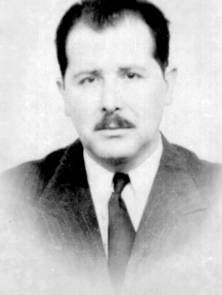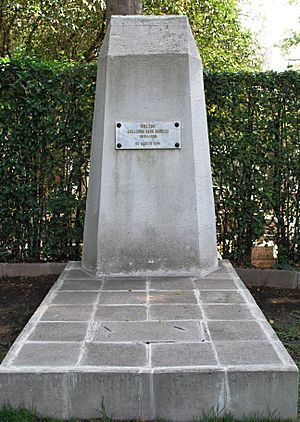Guillermo Haro facts for kids
Quick facts for kids
Guillermo Haro Barraza
|
|
|---|---|

Dr. Guillermo Haro Barraza
|
|
| Born | 21 March 1913 Mexico City, Mexico
|
| Died | 26 April 1988 (aged 75) |
| Alma mater | National Autonomous University of Mexico (UNAM) |
| Spouse(s) | Gladys Learn Rojas Elena Poniatowska |
| Scientific career | |
| Fields | Astronomy |
Guillermo Haro Barraza (born March 21, 1913 – died April 26, 1988) was a famous Mexican astronomer. He helped build modern observational astronomy in Mexico. He did this through his own amazing research and by creating new science centers. Around the world, he is most known for helping discover special objects in space called Herbig–Haro objects.
Contents
Early Life and Education
Guillermo Haro was born in Mexico City on March 21, 1913. His parents were Ignacio Haro and Leonor Barraza. He first studied philosophy and law at the National Autonomous University of Mexico (UNAM).
While working as a reporter for Excélsior, Haro became very interested in astronomy. This happened after he interviewed Luis Enrique Erro in 1937. Because he was so dedicated, Erro hired him in 1943. Haro became an assistant at the new Observatorio Astrofísico de Tonantzintla. Erro also helped Haro get more training in astronomy in the United States. He studied at places like the Harvard College Observatory and Yerkes Observatory.
Career in Astronomy
When Haro returned to Mexico in 1945, he kept working at the Tonantzintla Observatory. He helped set up a new 24-31-inch Schmidt camera. He also started studying very red and very blue stars. In 1947, he began working for the UNAM's Observatorio de Tacubaya.

Haro made many important discoveries in astronomy. He found many planetary nebulae near the center of our galaxy. He also discovered special non-stellar objects in dense clouds where new stars are forming. These are now called Herbig–Haro objects, named after him and George Herbig.
Haro and his team also found flare stars in the Orion nebula. Later, they found them in other groups of stars of different ages.
Another big project was a list of 8746 blue stars. He published this list with W. J. Luyten in 1961. They used the 48-inch Palomar Schmidt telescope for this work. At least 50 of these objects later turned out to be quasars. Quasars had not even been discovered yet in 1961! Haro also made a list of 44 blue galaxies in 1956. This work helped other scientists search for similar galaxies later on. Haro also found many T Tauri stars, one supernova, over 10 novae, and one comet.
Major Achievements and Influence
Guillermo Haro greatly influenced the growth of astronomy in Mexico. He did this not only through his own research but also by helping to create new scientific organizations. He helped define modern astrophysics in Mexico. He started different research areas and set up important science policies.
Haro and his American colleague George Herbig discovered a new type of large nebulae. These were named Herbig-Haro objects in their honor.
Haro became a member of the Colegio Nacional when he was 40. He was the youngest person ever to join this important group. In 1959, Haro was the first person from Mexico to be chosen for the Royal Astronomical Society. Some of his famous students include Silvia Torres-Peimbert and Manuel Peimbert.
Haro also founded the Mexican Academy of Sciences in 1960, where he was the first president. He also helped create the National Institute of Astrophysics, Optics and Electronics (INAOE). There is an observatory named after him in Sonora, Mexico.
Recognition and Legacy
The Galaxy Haro 11 (H11) is a small galaxy in the Sculptor constellation. It is named after Haro because he first included it in a study in 1956.
The Guillermo Haro International Program on Advanced Astrophysical Research at INAOE was named after him in August 1995.
On March 21, 2018, which was 105 years after his birth, Google honored Haro with a special Google Doodle.
Personal Life
In 1968, Haro married the journalist and writer Elena Poniatowska. They had two children, Felipe and Paula. Before this, he was divorced from his first wife, Gladys Learn Rojas.
Guillermo Haro passed away on April 27, 1988, in Mexico City. He is buried in the Rotonda de las Personas Ilustres at the Panteón Civil de Dolores.
See also
- Guillermo Haro Observatory
- In Spanish: Guillermo Haro Barraza para niños


